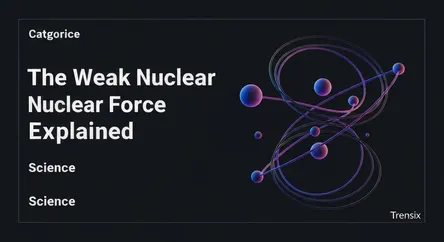Science
The Weak Nuclear Force Explained

An essential guide to the weak nuclear force, one of the four fundamental forces of nature responsible for radioactive decay and powering the sun.
What is it?
The weak nuclear force, or weak interaction, is one of the four fundamental forces of nature, alongside the strong nuclear force, electromagnetism, and gravity. Its most unique characteristic is its ability to change the subatomic particles' "flavor," for example, by converting a neutron into a proton, which is a process known as beta decay. This interaction is mediated by heavy particles known as W and Z bosons. As its name suggests, it is weaker than the strong and electromagnetic forces and operates only over extremely short, subatomic distances.
Why is it trending?
The weak nuclear force is central to the Standard Model of particle physics. Scientists are conducting high-precision experiments to measure its effects, as any deviation from theoretical predictions could signal the existence of new, undiscovered particles or forces. Recent research has focused on the interplay between the weak force and electromagnetism to refine our understanding of fundamental symmetries in the universe. This ongoing research pushes the boundaries of our knowledge and tests the limits of the Standard Model, keeping the weak force a hot topic in modern physics.
How does it affect people?
Despite its name, the weak force is crucial for life. It initiates the nuclear fusion process in the sun, which provides Earth with light and heat. By converting protons to neutrons, it allows for the formation of elements heavier than hydrogen. This process of radioactive decay is harnessed for practical applications like radiocarbon dating, used in archaeology to determine the age of artifacts. Additionally, principles of weak force decay are utilized in medical imaging techniques such as Positron Emission Tomography (PET) scans, making it a vital force in both nature and technology.